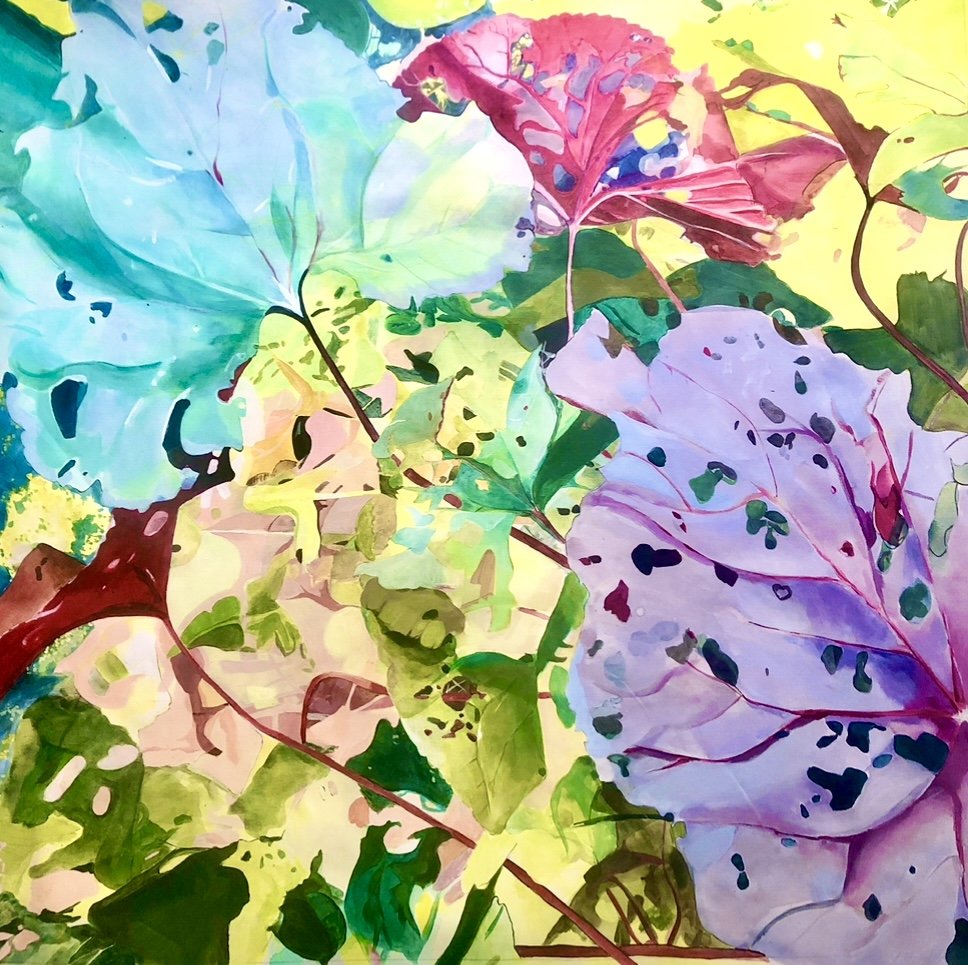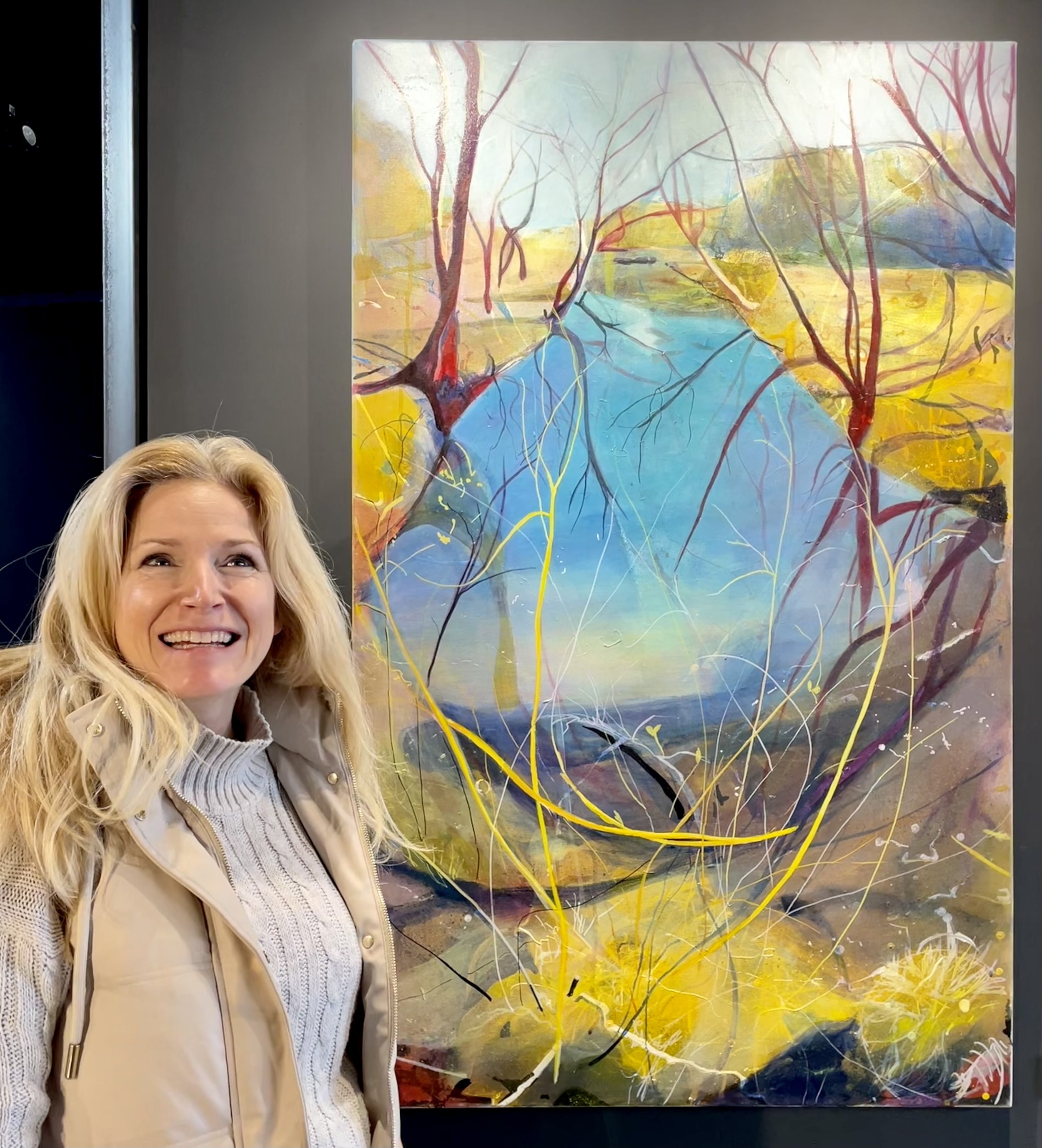ARTIST INTERVIEW: Inga Street
Please can you give me an introduction about yourself?
I think of myself as a figurative abstract painter, but there is a lot of space between figurative and abstract, so my paintings fall somewhere along this scale. The reality that is created in my work is based in the natural world, yet the colours are more intense, making what appears to be more magical spaces. I’m interested in reflections in water and interweaving branches, both in different ways conceal and reveal, so I’m looking to see what is beyond, underneath, or at the periphery of our vision. I’m looking at what is real, when the layers are peeled back.
Tell me about your journey to becoming an artist?
My mother is, and my grandmother was an artist, so I grew up painting. It’s a part of me that I can’t imagine not being there. When my youngest child was a toddler, I went back to college to study A level Art, then a Foundation Course at Arts University Bournemouth and culminating in BA in Fine Art at Central Saint Martins. Apart from the final year, it was all part time. Doing formal art study created deadlines and made me produce more work and think more deeply about what I was doing and why. You don’t need to go to college to be an artist but personally I found it helpful.
Describe your creative process; from start to finish of one of your works. Where do you find your inspiration?
I find inspiration in the twisting and turning branches of trees and their reflections in a pond or lake. I take lots of photographs and make sketches. I look for an image that makes me feel something and that has a depth of field. The surface of a pond has the ability to show what is behind our vantage point, the surface of the water and what is below the surface as well. Trees grouped together have space between the branches like a tapestry of layers.
Once I get to the studio, I take a roll of canvas and lay it on the floor, then I draw sacred geometry. The idea is to put layers of positive energy into the painting. Then, I add gold paint and gold leaf to some areas, followed by more thin layers of paint. Once I have a good foundation, I start to paint the image that inspired me. At some point I’ll stretch the canvas onto stretcher bars. The different layers of paint continue to build up and these hold traces of the time spent. Eventually, there is a sense of completion or I may put on a wall to contemplate the next step. Sometimes I’ll go back to a painting after a big gap, or other times there is nothing to add so it ends up finished. There is an element of the paintings having a life of their own.
What message would you like to get across in your work?
I hope that people feel as is they are entering a magical world when they look at my work, as if they are looking at an idealised version of reality. I would like the energy in the painting to give them positive vibrations in the same way that a fire gives off heat. I’d like the viewer to feel serenity, calm, connection, joy, energised or peaceful.
How have your surroundings influenced your work?
Being in nature has enhanced me as a person. I spend a lot of time outside. The trees and plants around us give energy and a sense of peace. When I lived in London, Kew Gardens was my mews and now I live near the beach and find myself walking in the woods a lot. The New Forest is close by and I can walk to the beach from my home, through beautiful wooded gardens with pine trees and rhododendrons.
What is your favourite piece you have created and why?
My current favourite is ‘Under an Emerald Canopy’. It’s of a woodland that I’ve visited often and it makes me feel safe, calm and content. It feels like a true expression of my intention.
Under an Emerald Canopy
Who is your favourite artist and why? Do they have an influence on your work?
I have lots of favourites, Peter Doig, Helen Chadwick, Van Gogh, Georgia O’Keefe, Helen Frankenthaler, Yoyoi Kusama to name a few. The one who has make me think the most is David Hockney. He talks about how the camera has changed our way of looking at the world and his book Secret Knowledge, which is also a BBC program, are well worth spending some time with. I have been very influenced by his thoughts on our perception of our reality and how we look differently at the world since the invention of glass and lenses.
What has been your greatest achievement so far as an artist?
I was in an exhibition at Camden Arts Centre, which was pretty amazing. I got to spend a month or so in the gallery and during that time, the main exhibition was Pino Pascali from the Arte Povera movement. I spent a lot of time sat on the floor sketching his work and in the garden there. In the end, the finished piece I made was a screen print of a photograph on perspex and aluminium. It was of the window in the cafe and the refections of the outside overlaid on the scene inside.
My greatest achievement though was having people viewing the more recent work, tell me that they could feel the energy in the paintings and how calm or energised or happy it made them feel.
Why is art important in society?
I think of art as a language in the same way as English or French, Music or Mathematics. Art is the language of the emotions and a way to speak to and from our souls. It can elevate our wellbeing or scream of our pain. There are times when words aren’t enough and art and music are eloquent and elegant alternatives.













